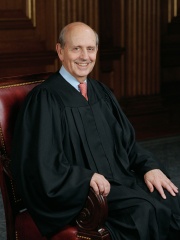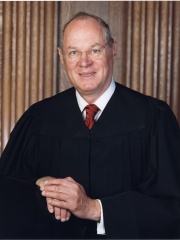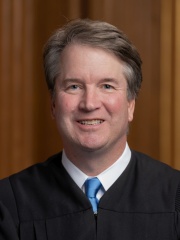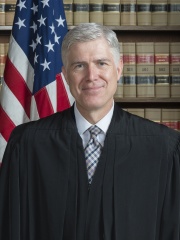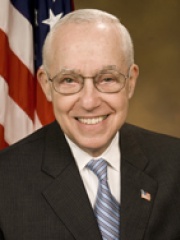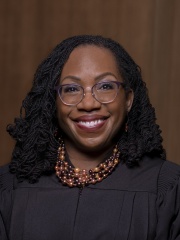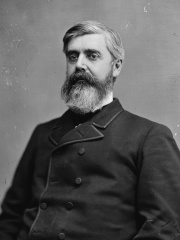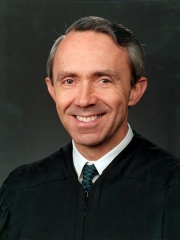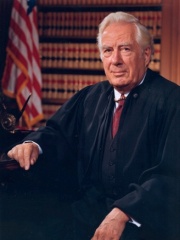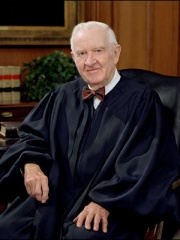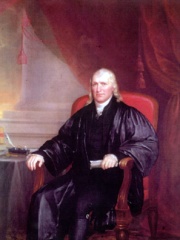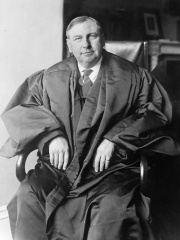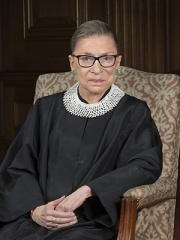
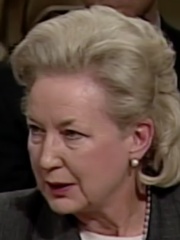
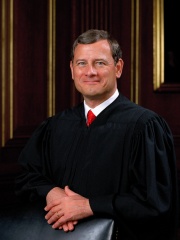
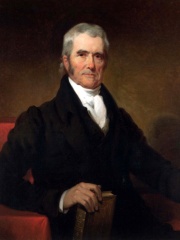
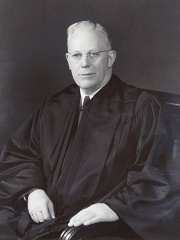
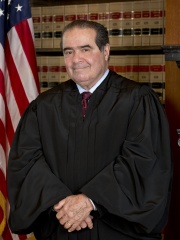
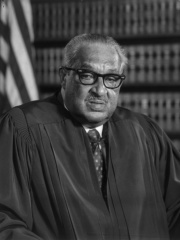
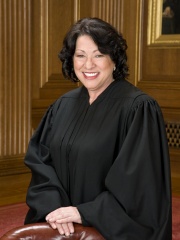
The Most Famous
JUDGES from United States
This page contains a list of the greatest American Judges. The pantheon dataset contains 53 Judges, 26 of which were born in United States. This makes United States the birth place of the most number of Judges.
Top 10
The following people are considered by Pantheon to be the top 10 most legendary American Judges of all time. This list of famous American Judges is sorted by HPI (Historical Popularity Index), a metric that aggregates information on a biography's online popularity. Visit the rankings page to view the entire list of American Judges.

1. Ruth Bader Ginsburg (1933 - 2020)
With an HPI of 67.15, Ruth Bader Ginsburg is the most famous American Judge. Her biography has been translated into 70 different languages on wikipedia.
Joan Ruth Bader Ginsburg ( BAY-dər GHINZ-burg; née Bader; March 15, 1933 – September 18, 2020) was an American lawyer and jurist who served as an associate justice of the Supreme Court of the United States from 1993 until her death in 2020. She was nominated by President Bill Clinton to replace retiring justice Byron White, and at the time was viewed as a moderate consensus-builder. Ginsburg was the first Jewish woman and the second woman to serve on the Court, after Sandra Day O'Connor. During her tenure, Ginsburg authored the majority opinions in cases such as United States v. Virginia (1996), Olmstead v. L.C. (1999), Friends of the Earth, Inc. v. Laidlaw Environmental Services, Inc. (2000), and City of Sherrill v. Oneida Indian Nation of New York (2005). Later in her tenure, Ginsburg received attention for passionate dissents that reflected liberal views of the law. Ginsburg was born and grew up in Brooklyn, New York. Just over a year later her older sister and only sibling, Marilyn, died of meningitis at the age of six. Her mother died shortly before she graduated from high school. She earned her bachelor's degree at Cornell University and married Martin D. Ginsburg, becoming a mother before starting law school at Harvard, where she was one of the few women in her class. Ginsburg transferred to Columbia Law School, where she graduated joint first in her class. During the early 1960s she worked with the Columbia Law School Project on International Procedure, learned Swedish, and co-authored a book with Swedish jurist Anders Bruzelius; her work in Sweden profoundly influenced her thinking on gender equality. She then became a professor at Rutgers Law School and Columbia Law School, teaching civil procedure as one of the few women in her field and the first female member of the law faculty at Columbia to attain tenure. Ginsburg spent much of her legal career as an advocate for gender equality and women's rights, winning many arguments before the Supreme Court. She advocated as a volunteer attorney for the American Civil Liberties Union and was a member of its board of directors and one of its general counsel in the 1970s. In 1980, President Jimmy Carter appointed her to the U.S. Court of Appeals for the District of Columbia Circuit, where she served until her appointment to the Supreme Court in 1993. Between O'Connor's retirement in 2006 and the appointment of Sonia Sotomayor in 2009, she was the only female justice on the Supreme Court. During that time, Ginsburg became more forceful with her dissents, such as with Ledbetter v. Goodyear Tire & Rubber Co. (2007). Despite two bouts with cancer and public pleas from liberal law scholars, she decided not to retire in 2013 or 2014 when President Barack Obama and a Democratic-controlled Senate could appoint and confirm her successor. Ginsburg died at her home in Washington, D.C., on 18 September 2020, at the age of 87, from complications of metastatic pancreatic cancer. The vacancy created by her death was filled 39 days later by Amy Coney Barrett. The result was one of three major rightward shifts in the Court since 1953, following the appointment of Clarence Thomas to replace Thurgood Marshall in 1991 and the appointment of Warren Burger to replace Earl Warren in 1969.

2. Maryanne Trump Barry (1937 - 2023)
With an HPI of 66.63, Maryanne Trump Barry is the 2nd most famous American Judge. Her biography has been translated into 22 different languages.
Maryanne Trump Barry (April 5, 1937 – November 13, 2023) was an American attorney and United States federal judge. She became an assistant United States attorney in 1974 and was first appointed to the United States District Court for the District of New Jersey by President Ronald Reagan in 1983. In 1999, she was appointed to the United States Court of Appeals for the Third Circuit by Bill Clinton. In January 2006, Barry testified before the U.S. Senate Judiciary Committee in support of the nomination of her colleague Samuel Alito to the U.S. Supreme Court. She took senior status in June 2011, and announced her retirement from the bench in February 2019 after an investigation was launched into allegations that she had committed judicial misconduct by participating in fraudulent tax and financial transactions. Barry was the eldest sister of 45th and 47th President of the United States Donald Trump.

3. John Roberts (b. 1955)
With an HPI of 62.80, John Roberts is the 3rd most famous American Judge. His biography has been translated into 53 different languages.
John Glover Roberts Jr. (born January 27, 1955) is an American jurist who has served since 2005 as the 17th chief justice of the United States. Though primarily an institutionalist, he has been described as having a moderate conservative judicial philosophy. Regarded as a swing vote in some cases, Roberts has presided over an ideological shift toward conservative jurisprudence on the high court, in which he has authored key opinions. Born in Buffalo, New York, Roberts was raised Catholic in Northwest Indiana and studied at Harvard University, initially intending to become a historian. He graduated in three years with highest distinction, then attended Harvard Law School, where he was the managing editor of the Harvard Law Review. Roberts later served as a law clerk for Judge Henry Friendly and Justice William Rehnquist and held positions in the Department of Justice from 1989 to 1993 during the presidencies of Ronald Reagan and George H. W. Bush. Roberts then built a leading appellate practice, arguing 39 cases before the Supreme Court. In 1992, Bush nominated Roberts to the U.S. Court of Appeals for the District of Columbia Circuit, but the Senate did not hold a confirmation vote. In 2003, Roberts was appointed to that circuit court by President George W. Bush, who in 2005 nominated him to the Supreme Court—initially as an associate justice to fill the vacancy left by Justice Sandra Day O'Connor and then to chief justice after William Rehnquist's death. Roberts was confirmed by a Senate vote of 78–22. Aged 50, he was the youngest chief justice since John Marshall, who assumed the office at age 46. As chief justice, Roberts has authored majority opinions in many landmark cases, including National Federation of Independent Business v. Sebelius (upholding most sections of the Affordable Care Act), Shelby County v. Holder (limiting the Voting Rights Act of 1965), Trump v. Hawaii (expanding presidential powers over immigration), Carpenter v. United States (expanding digital privacy), Students for Fair Admissions v. Harvard (overruling race-based admission programs), and Trump v. United States (outlining the extent of presidential immunity from criminal prosecution). Roberts also presided over President Donald Trump's first impeachment trial.

4. John Marshall (1755 - 1835)
With an HPI of 61.18, John Marshall is the 4th most famous American Judge. His biography has been translated into 44 different languages.
John Marshall (September 24, 1755 – July 6, 1835) was an American statesman, jurist, and Founding Father who served as the fourth chief justice of the United States from 1801 until his death in 1835. He remains the longest-serving chief justice and fourth-longest-serving justice in the history of the U.S. Supreme Court, and he is widely regarded as one of the most influential justices ever to serve. Prior to joining the court, Marshall briefly served as both the U.S. secretary of state under President John Adams and a U.S. representative from Virginia, making him one of the few Americans to have held a constitutional office in each of the three branches of the United States federal government. Marshall was born in Germantown in the Colony of Virginia in British America in 1755. After the outbreak of the American Revolutionary War, he joined the Continental Army, serving in numerous battles. During the later stages of the war, he was admitted to the state bar and won election to the Virginia House of Delegates. Marshall favored the ratification of the U.S. Constitution, and he played a major role in Virginia's ratification of that document. At the request of President Adams, Marshall traveled to France in 1797 to help bring an end to attacks on American shipping. In what became known as the XYZ Affair, the government of France refused to open negotiations unless the United States agreed to pay bribes. Upon his return from France, he led the Federalist Party in Congress. He was appointed secretary of state in 1800 after a cabinet shake-up, becoming an important figure in the Adams administration. In 1801, Adams appointed Marshall to the Supreme Court. Marshall quickly emerged as the key figure on the court, due in large part to his personal influence with the other justices. Under his leadership, the court moved away from seriatim opinions, instead issuing a single majority opinion that elucidated a clear rule. The 1803 case of Marbury v. Madison presented the first major case heard by the Marshall Court. In his opinion for the court, Marshall upheld the principle of judicial review, whereby courts could strike down federal and state laws if they conflicted with the Constitution. Marshall's holding avoided direct conflict with the executive branch, which was led by Democratic-Republican president Thomas Jefferson. By establishing the principle of judicial review while avoiding an inter-branch confrontation, Marshall helped implement the principle of separation of powers and cement the position of the American judiciary as an independent and co-equal branch of government. After 1803, many of the major decisions issued by the Marshall Court confirmed the supremacy of the federal government and the federal Constitution over the states. In Fletcher v. Peck and Dartmouth College v. Woodward, the court invalidated state actions because they violated the Contract Clause. The court's decision in McCulloch v. Maryland upheld the constitutionality of the Second Bank of the United States and established the principle that the states could not tax federal institutions. The cases of Martin v. Hunter's Lessee and Cohens v. Virginia established that the Supreme Court could hear appeals from state courts in both civil and criminal matters. Marshall's opinion in Gibbons v. Ogden established that the Commerce Clause bars states from restricting navigation. In the case of Worcester v. Georgia, Marshall held that the Georgia criminal statute that prohibited non-Native Americans from being present on Native American lands without a license from the state was unconstitutional. Marshall died of natural causes in 1835, and Andrew Jackson appointed Roger Taney as his successor.
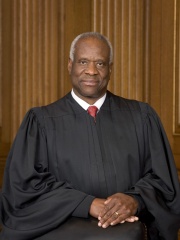
5. Clarence Thomas (b. 1948)
With an HPI of 60.15, Clarence Thomas is the 5th most famous American Judge. His biography has been translated into 41 different languages.
Clarence Thomas (born June 23, 1948) is an American lawyer and jurist who has served since 1991 as an associate justice of the Supreme Court of the United States. President George H. W. Bush nominated him to succeed Thurgood Marshall. After Marshall, Thomas is the second African American to serve on the U.S. Supreme Court and has been its longest-serving member since Anthony Kennedy's retirement in 2018. He has also been the Court's oldest member since Stephen Breyer retired in 2022. Thomas was born in Pin Point, Georgia. After his father abandoned the family, he was raised by his grandfather in a poor Gullah community near Savannah, Georgia. Growing up as a devout Catholic, Thomas originally intended to be a priest in the Catholic Church but became dissatisfied with its efforts to combat racism and abandoned his aspiration to join the clergy. He graduated with honors from the College of the Holy Cross in 1971 and earned his Juris Doctor in 1974 from Yale Law School. Upon graduating, he was appointed as an assistant attorney general in Missouri and later entered private practice there. He became a legislative assistant to U.S. senator John Danforth in 1979, and was made Assistant Secretary for Civil Rights at the U.S. Department of Education in 1981. President Ronald Reagan appointed Thomas as Chairman of the Equal Employment Opportunity Commission (EEOC) the next year. President George H. W. Bush nominated Thomas to the United States Court of Appeals for the District of Columbia Circuit in 1990. He served in that role for 19 months before filling Marshall's seat on the Supreme Court. Thomas's confirmation hearings were bitter and intensely fought, centering on an accusation that he had sexually harassed Anita Hill, a subordinate at the Department of Education and the EEOC. The Senate confirmed Thomas by a vote of 52–48, the narrowest margin in a century. Since the death of Antonin Scalia, Thomas has been the Court's foremost originalist, stressing what he considers the original meaning in interpreting the U.S. Constitution. In contrast to Scalia—who had been the only other consistent originalist—he pursues a more classically liberal variety of originalism. Until 2020, Thomas was known for his silence during most oral arguments, though he has since begun asking more questions to counsel. He is notable for his majority opinions in Good News Club v. Milford Central School (determining the freedom of religious speech in relation to the First Amendment to the U.S. Constitution) and New York State Rifle & Pistol Association, Inc. v. Bruen (affirming the individual right to bear arms outside the home), as well as his dissent in Gonzales v. Raich (arguing that the U.S. Congress may not criminalize the private cultivation of medical cannabis). He is widely considered to be the Court's most conservative member.

6. Earl Warren (1891 - 1974)
With an HPI of 60.11, Earl Warren is the 6th most famous American Judge. His biography has been translated into 36 different languages.
Earl Warren (March 19, 1891 – July 9, 1974) was an American attorney and politician who served as the 30th governor of California from 1943 to 1953, and as the 14th chief justice of the United States from 1953 to 1969. The Warren Court presided over a major shift in American constitutional jurisprudence, which has been recognized by many as a "constitutional revolution" in the liberal direction, with Warren writing the majority opinions in landmark cases such as Brown v. Board of Education (1954), Reynolds v. Sims (1964), Miranda v. Arizona (1966), and Loving v. Virginia (1967). Warren also led the Warren Commission, a presidential commission that investigated the 1963 assassination of President John F. Kennedy. Warren is the last Chief Justice to have served in an elected office before nomination to the Supreme Court, and is generally considered to be one of the most influential Supreme Court justices and political leaders in the history of the United States. Warren was born in 1891 in Los Angeles and was raised in Bakersfield, California. After graduating from the University of California, Berkeley, School of Law, he began a legal career in Oakland. He was hired as a deputy district attorney for Alameda County in 1920 and was appointed district attorney in 1925. He emerged as a leader of the state Republican Party and won election as the attorney general of California in 1938. In that position he supported, and was a firm proponent of the forced removal and internment of over 100,000 Japanese Americans during World War II. In the 1942 California gubernatorial election, Warren defeated incumbent Democratic governor Culbert Olson. As the 30th Governor of California, Warren presided over a period of major growth—for the state as well as the nation. Serving from 1943 to 1953, Warren is the only governor of California to be elected for three consecutive terms. Warren served as Thomas E. Dewey's running mate in the 1948 presidential election, but the ticket lost the election to incumbent president Harry S. Truman and Senator Alben W. Barkley in an election upset. Warren sought the Republican nomination in the 1952 presidential election, but the party nominated General Dwight D. Eisenhower. After Eisenhower won election as president, he appointed Warren as Chief Justice. A series of rulings made by the Warren Court in the 1950s helped lead to the decline of McCarthyism. Warren helped arrange a unanimous decision in Brown v. Board of Education (1954), which ruled that racial segregation in public schools was unconstitutional. After Brown, the Warren Court continued to issue rulings that helped bring an end to the segregationist Jim Crow laws that were prevalent throughout the Southern United States. In Heart of Atlanta Motel, Inc. v. United States (1964), the Court upheld the Civil Rights Act of 1964, a federal law that prohibits racial segregation in public institutions and public accommodations. In the 1960s, the Warren Court handed down several landmark rulings that significantly transformed criminal procedure, redistricting, and other areas of the law. Many of the Court's decisions incorporated the Bill of Rights, making the protections of the Bill of Rights apply to state and local governments. Gideon v. Wainwright (1963) established a criminal defendant's right to an attorney in felony cases, and Miranda v. Arizona (1966) required police officers to give what became known as the Miranda warning to suspects taken into police custody that advises them of their constitutional protections. Reynolds v. Sims (1964) established that all state legislative districts must be of roughly equal population size, while the Court's holding in Wesberry v. Sanders (1964) required equal populations for congressional districts, thus achieving "one man, one vote" in the United States. Schmerber v. California (1966) established that forced extraction of a blood sample is not compelled testimony, illuminating the limits on the protections of the 4th and 5th Amendments and Warden v. Hayden (1967) dramatically expanded the rights of police to seize evidence with a search warrant, reversing the mere evidence rule. Furthermore, Griswold v. Connecticut (1965) established a constitutional right to privacy and struck down a state law that restricted access to contraceptives, and Loving v. Virginia (1967) struck down state anti-miscegenation laws, which had banned or otherwise regulated interracial marriage. Warren announced his retirement in 1968 and was succeeded by Appellate Judge Warren E. Burger in 1969. The Warren Court's rulings have received both support and criticism from liberals and conservatives alike, and few of the Court's decisions have been overturned.

7. Antonin Scalia (1936 - 2016)
With an HPI of 59.16, Antonin Scalia is the 7th most famous American Judge. His biography has been translated into 43 different languages.
Antonin Gregory Scalia (March 11, 1936 – February 13, 2016) was an American jurist who served as an associate justice of the Supreme Court of the United States from 1986 until his death in 2016. He was described as the intellectual anchor for the originalist and textualist position in the U.S. Supreme Court's conservative wing. For catalyzing an originalist and textualist movement in American law, he has been described as one of the most influential jurists of the twentieth century, and one of the most important justices in the history of the Supreme Court. Scalia was posthumously awarded the Presidential Medal of Freedom in 2018, and the Antonin Scalia Law School at George Mason University was named in his honor. Scalia was born in Trenton, New Jersey. A devout Catholic, he attended the Jesuit Xavier High School before receiving his undergraduate degree from Georgetown University. Scalia went on to graduate from Harvard Law School and spent six years at Jones Day before becoming a law professor at the University of Virginia. In the early 1970s, he served in the Nixon and Ford administrations, eventually becoming an assistant attorney general under President Gerald Ford. He spent most of the Carter years teaching at the University of Chicago, where he became one of the first faculty advisers of the fledgling Federalist Society. In 1982, President Ronald Reagan appointed Scalia as a judge of the U.S. Court of Appeals for the District of Columbia Circuit. Four years later, Reagan appointed him to the Supreme Court, where Scalia became its first Italian-American justice following a unanimous confirmation by the U.S. Senate 98–0. Scalia espoused a conservative jurisprudence and ideology, advocating textualism in statutory interpretation and originalism in constitutional interpretation. He peppered his colleagues with "Ninograms" (memos named for his nickname, "Nino") intending to persuade them to his point of view. He was a strong defender of the powers of the executive branch and believed that the U.S. Constitution permitted the death penalty and did not guarantee the right to either abortion or same-sex marriage. Furthermore, Scalia viewed affirmative action and other policies that afforded special protected status to minority groups as unconstitutional. Such positions would earn him a reputation as one of the most conservative justices on the Court. He filed separate opinions in many cases, often castigating the Court's majority—sometimes scathingly so. Scalia's most significant opinions include his lone dissent in Morrison v. Olson (arguing against the constitutionality of an Independent-Counsel law), and his majority opinions in Crawford v. Washington (defining a criminal defendant's confrontation right under the Sixth Amendment) and District of Columbia v. Heller (holding that the Second Amendment to the U.S. Constitution guarantees an individual right to handgun ownership).

8. Thurgood Marshall (1908 - 1993)
With an HPI of 58.86, Thurgood Marshall is the 8th most famous American Judge. His biography has been translated into 37 different languages.
Thoroughgood "Thurgood" Marshall (July 2, 1908 – January 24, 1993) was an American civil rights lawyer and jurist who served as an associate justice of the Supreme Court of the United States from 1967 until 1991. He was the Supreme Court's first African-American justice. Before his judicial service, he was an attorney who fought for civil rights, leading the NAACP Legal Defense and Educational Fund. Marshall was a prominent figure in the movement to end racial segregation in American public schools. He won 29 of the 32 civil rights cases he argued before the Supreme Court, culminating in the Court's landmark 1954 decision in Brown v. Board of Education, which rejected the separate but equal doctrine and held segregation in public education to be unconstitutional. President Lyndon B. Johnson appointed Marshall to the Supreme Court in 1967. A staunch liberal, he frequently dissented as the Court became increasingly conservative. Born in Baltimore, Maryland, Marshall attended Lincoln University and the Howard University School of Law. At Howard, he was mentored by Charles Hamilton Houston, who taught his students to be "social engineers" willing to use the law to fight for civil rights. Marshall opened a law practice in Baltimore but soon joined Houston at the NAACP in New York. They worked together on the segregation case of Missouri ex rel. Gaines v. Canada; after Houston returned to Washington, Marshall took his place as special counsel of the NAACP, and he became director-counsel of the newly formed NAACP Legal Defense and Educational Fund. He participated in numerous landmark Supreme Court cases involving civil rights, including Smith v. Allwright, Morgan v. Virginia, Shelley v. Kraemer, McLaurin v. Oklahoma State Regents, Sweatt v. Painter, Brown, and Cooper v. Aaron. His approach to desegregation cases emphasized the use of sociological data to show that segregation was inherently unequal. In 1961, President John F. Kennedy appointed Marshall to the U.S. Court of Appeals for the Second Circuit, where he favored a broad interpretation of constitutional protections. Four years later, Johnson appointed him as the U.S. Solicitor General. In 1967, Johnson nominated Marshall to replace Justice Tom C. Clark on the Supreme Court; despite opposition from Southern senators, he was confirmed by a 69–11 vote. He was often in the majority during the consistently liberal Warren Court period, but after appointments by President Richard Nixon made the Court more conservative, Marshall frequently found himself in dissent. His closest ally on the Court was Justice William J. Brennan Jr., and the two voted the same way in most cases. Marshall's jurisprudence was pragmatic and drew on his real-world experience. His most influential contribution to constitutional doctrine, the "sliding-scale" approach to the Equal Protection Clause, called on courts to apply a flexible balancing test instead of a more rigid tier-based analysis. He fervently opposed the death penalty, which in his view constituted cruel and unusual punishment; he and Brennan dissented in more than 1,400 cases in which the majority refused to review a death sentence. He favored a robust interpretation of the First Amendment in decisions such as Stanley v. Georgia, and he supported abortion rights in Roe v. Wade and other cases. Marshall retired from the Supreme Court in 1991 and was replaced by Clarence Thomas. He died in 1993.

9. Sonia Sotomayor (b. 1954)
With an HPI of 58.69, Sonia Sotomayor is the 9th most famous American Judge. Her biography has been translated into 53 different languages.
Sonia Maria Sotomayor ( , Spanish: [ˈsonja sotomaˈʝoɾ]; born June 25, 1954) is an American lawyer and jurist who serves as an associate justice of the Supreme Court of the United States. She was nominated by President Barack Obama on May 26, 2009, and has served since August 8, 2009. She is the first Hispanic justice and the third woman U.S. Supreme Court justice. Sotomayor was born in the Bronx, New York City, to Puerto Rican-born parents. Her father died when she was nine, and she was subsequently raised by her mother. She graduated with high honors from Princeton University in 1976 and received her Juris Doctor in 1979 from Yale Law School, where she was an editor of the Yale Law Journal. She worked as an assistant district attorney in New York for four and a half years before entering private practice in 1984. She played an active role on the boards of directors for the Puerto Rican Legal Defense and Education Fund, the State of New York Mortgage Agency, and the New York City Campaign Finance Board. President George H. W. Bush nominated Sotomayor to the U.S. District Court for the Southern District of New York in 1991; she was confirmed in 1992. In 1997, President Bill Clinton nominated her to the U.S. Court of Appeals for the Second Circuit. That appointment was slowed by the Republican majority in the United States Senate because of its concerns that the position might lead to a Supreme Court nomination, but she was confirmed in 1998. On the Second Circuit, Sotomayor heard appeals in more than 3,000 cases and wrote about 380 opinions. Sotomayor has taught at the New York University School of Law and Columbia Law School. In May 2009, President Barack Obama nominated Sotomayor to the Supreme Court following Justice David Souter's retirement. Her nomination was confirmed by the Senate in August 2009 by a vote of 68–31. While on the Court, Sotomayor has supported the informal liberal bloc of justices when they divide along the commonly perceived ideological lines. During her Supreme Court tenure, Sotomayor has been identified with concern for the rights of criminal defendants and criminal justice reform, as demonstrated in majority opinions such as J. D. B. v. North Carolina. She is also known for her impassioned dissents on issues of race and ethnic identity, including in Schuette v. BAMN, Utah v. Strieff, and Trump v. Hawaii.
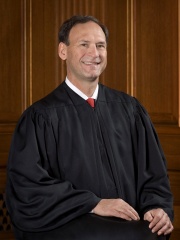
10. Samuel Alito (b. 1950)
With an HPI of 57.53, Samuel Alito is the 10th most famous American Judge. His biography has been translated into 39 different languages.
Samuel Anthony Alito Jr. ( ə-LEE-toh; born April 1, 1950) is an American jurist who serves as an associate justice of the Supreme Court of the United States. He was nominated to the high court by President George W. Bush on October 31, 2005, and has served on it since January 31, 2006. After Antonin Scalia, Alito is the second Italian American justice to serve on the U.S. Supreme Court. Alito was raised in Hamilton Township, New Jersey, and graduated from Princeton University and Yale Law School. After law school, he worked as an assistant attorney general for the Office of Legal Counsel and served as the U.S. attorney for the District of New Jersey. In 1990, Alito was appointed as a judge on the U.S. Court of Appeals for the Third Circuit, where he served until joining the Supreme Court. He has called himself a "practical originalist" and is a member of the Supreme Court's conservative bloc. Alito has written majority opinions in the landmark cases McDonald v. Chicago (2010) on firearm rights, Burwell v. Hobby Lobby (2014) on insurance coverage, Janus v. AFSCME (2018) on public-sector union security agreements, and Dobbs v. Jackson Women's Health Organization (2022) on abortion.
People
Pantheon has 26 people classified as American judges born between 1741 and 1970. Of these 26, 11 (42.31%) of them are still alive today. The most famous living American judges include John Roberts, Clarence Thomas, and Sonia Sotomayor. The most famous deceased American judges include Ruth Bader Ginsburg, Maryanne Trump Barry, and John Marshall.
Living American Judges
Go to all RankingsJohn Roberts
1955 - Present
HPI: 62.80
Clarence Thomas
1948 - Present
HPI: 60.15
Sonia Sotomayor
1954 - Present
HPI: 58.69
Samuel Alito
1950 - Present
HPI: 57.53
Stephen Breyer
1938 - Present
HPI: 57.17
Anthony Kennedy
1936 - Present
HPI: 55.16
Brett Kavanaugh
1965 - Present
HPI: 53.98
Elena Kagan
1960 - Present
HPI: 52.19
Neil Gorsuch
1967 - Present
HPI: 49.85
Michael Mukasey
1941 - Present
HPI: 49.32
Ketanji Brown Jackson
1970 - Present
HPI: 49.07
Deceased American Judges
Go to all RankingsRuth Bader Ginsburg
1933 - 2020
HPI: 67.15
Maryanne Trump Barry
1937 - 2023
HPI: 66.63
John Marshall
1755 - 1835
HPI: 61.18
Earl Warren
1891 - 1974
HPI: 60.11
Antonin Scalia
1936 - 2016
HPI: 59.16
Thurgood Marshall
1908 - 1993
HPI: 58.86
Walter Q. Gresham
1832 - 1895
HPI: 55.48
David Souter
1939 - 2025
HPI: 55.30
Warren E. Burger
1907 - 1995
HPI: 55.30
John Paul Stevens
1920 - 2019
HPI: 52.99
Samuel Chase
1741 - 1811
HPI: 51.73
Harlan F. Stone
1872 - 1946
HPI: 51.51
Overlapping Lives
Which Judges were alive at the same time? This visualization shows the lifespans of the 15 most globally memorable Judges since 1700.

